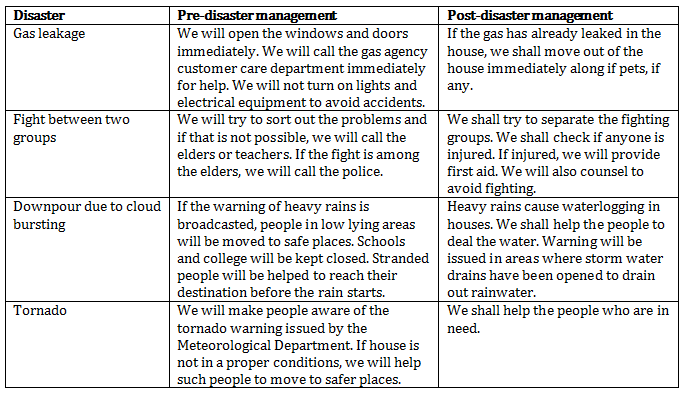Class 10 MAHARASHTRA STATE TEXTBOOK BUREAU Solutions Science Chapter 10 - Disaster Management
Disaster Management Exercise Exercise
Solution 1
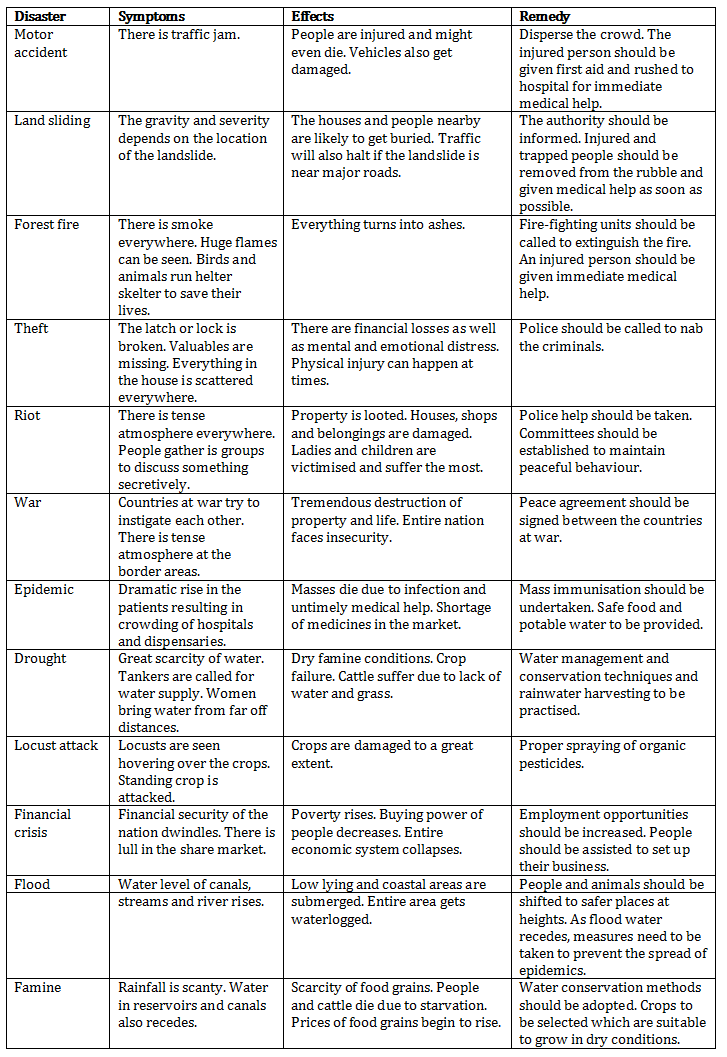
Solution 2.a
Disaster Management Authority
- Disaster Management Authority is a government body that works from the national level to the village level.
- It basically works for the management of a disaster and tackling the problems of the affected people.
- At the National level, there is National Disaster Management Authority in which the Prime Minister is the chairman.
- For every state, there is State Disaster Management Authority, where the chief minister of every state is the chairman.
- Under the state level, there are district level units where district collector is responsible for disaster management and implementation of rehabilitation schemes.
- Below district level authority, there are Taluka and then Village Disaster Management Committees. The Tahsildar is the chairman for the Taluka level while the Sarpanch of the village is responsible for the management of disasters at the village level.
- Collector of each district helps in planning, coordinating and controlling the implementation of rehabilitation programmes and also gives essential instructions and reviews the entire system.
Solution 2.b
Nature of disaster management
- Disaster management involves either prevention of the disasters (Pre-disaster management) or creating preparedness to face them (Post-disaster management).
- Action plans are prepared for managing disasters. This is done after studying different aspects such as preventive measures, rehabilitation and reconstruction plans.
- The disasters are tackled by executing action plans in the following steps:
- Preparation
- Redemption
- Preparedness
- Action during actual disaster
- Response
- Resurgence
- Restoration
- At every level there are other voluntary organizations and Government meteorological institutions for their help.
Solution 2.c
Mock drill
- Mock drill is the practice to check whether there is preparedness for dealing with a sudden attack of a disaster.
- Virtual or apparent situations that simulate the disaster are created for this purpose.
- The reaction time for any type of disaster is checked by such activity.
- The execution of the rescue plans are observed in the presence of a trained personnel.
- People also understand their responsibilities at the time of an actual disaster.
- The experts also check execution of the plan designed for disaster redressal.
- The efficacy of the entire disaster management system can be understood by such mock drills.
- In future, when actual calamity strikes, there is already preparation for disaster redressal. Therefore, mock drill is extremely essential.
Solution 2.d
Disaster Management Act, 2005
- The Government of India has passed the Disaster Management Act in 2005.
- The affected people are given all necessary help as per this act.
- With the humanitarian view, people are rehabilitated and helped to come back to normalcy after the disaster.
- As per this Act, National Disaster Response Force has been established. This force consists of 12 divisions across entire India. These divisions are attached to the Indian Army.
- Headquarter of the force is located in Delhi, but the action is taken all over the country with the help of the army.
- As per the Disaster Management Act, in Maharashtra National Disaster Response Force is in action through State Reserve Police Force.
- The personnel of this force are trained accordingly, and they take part in the rescue work during different disasters.
Solution 3.a
District control unit looks after disaster management at the district level. It is immediately formed either after the impact of the disaster or if warning is issued about some upcoming disaster.
District-wise Disaster Control Unit performs the following role:
- It reviews various aspects of disasters.
- There is continuous contact established with various agencies like army, air force, navy, telecommunication department and paramilitary forces through the disaster control unit for obtaining help.
- The unit also coordinates with various voluntary organizations for their help in disaster management.
Solution 3.b
- After World War-II, the feelings of peace and brotherhood among the global citizens were lost. Geographic, religious, racial and ethnic differences sprang up tremendously.
- Atrocities of the Nazis made deep impact on the minds of the people. Terrorism, abduction, robberies and social unrest increased in almost all the countries.
- There were financial losses during World War II. Science and technology was misused to retrieve these deficits.
- At the end of World War II, atomic bombs were dropped in Japan. This created health problems in the entire world.
- Social inequality, economic disparity, racial and religious differences were some adversaries that created unrest in the country.
- Later, the neighbouring nations kept on fighting. The geographical boundaries were changed.
- People always had feelings of insecurity. Terrorism flourished. All such instances gave rise to man-made disasters.
Solution 3.c
Objectives of disaster management:
- To save human life from disasters and help them in relocating from the area of disaster by rapid action.
- To supply essential commodities such as grains, water, clothes and other basic necessities to the affected people. This helps to reduce the gravity of the disaster.
- To bring back the conditions of the affected people to normalcy.
- To rehabilitate the affected and displaced victims.
- To think and execute protective measures in order to develop capability to face the disasters in future.
Solution 3.d
We need to immediately help the victim in case of a disaster. Till the medical help arrives, one should be in a position to treat the injured and save his or her life. Those who are injured should be treated at once. In such cases, knowledge of first-aid is essential. A disaster can strike anytime and a need for first aid may be required even for our parents, siblings at home or friends in school. If we are aware of the techniques of first aid, we can save the lives of these people before medical help arrives. Therefore, it is essential to get the training of first aid.
Solution 3.e
Following methods are used for the transportation of patients:
- Cradle method: This method is used for children and persons with less weight.
- Carrying piggy back: This method is useful for carrying unconscious persons.
- Human crutch method: If one leg of a person is injured, then the victim is supported with minimum load on the other leg. This is called human crutch method.
- Pulling or lifting method: This method is used for carrying an unconscious person for a short distance.
- Carrying on four-hand chair: This method is used when support is needed for a part below the waist region.
- Carrying on two-hand chair: Patients who cannot use their hands but can hold their body upright, are carried by this method.
- Stretcher: The unconscious patient can be moved by making a temporary stretcher in case of an emergency. Such temporary stretchers are made using bamboos or blankets.
Solution 4
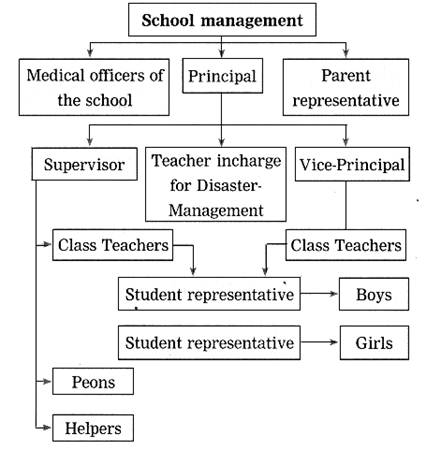
Solution 5

Solution 6
Following aspects would be inspected for pre-disaster management at school:
- Are the telephones of the school working properly?
- Is there a first-aid box in each class?
- Are there any basic medicines in the school?
- Is the team ready for rescue of smaller children from lower classes?
- Has the monitor or prefect participated in a mock drill? Does he/she know about first aid?
- Is the contact of parent representative available in emergency situations?
- Is the Medical Officer/Doctor present on the school campus?
- Is there enough drinking water and some dry snacks available in the school?
- Are the staircases and corridors suitable for quick evacuation of the children?
Solution 7
- Terrorism: Man-made, intentional.
Due to terrorism, many innocent lives are injured and often lost. Buildings, monuments and vehicles are completely destroyed. There is rift between different religions or sects. Peaceful atmosphere is disturbed. The entire society is under the constant fear of insecurity. - Soil erosion: Natural, geophysical, geological.
The soil becomes barren when the upper fertile layer of soil is lost. The trees are uprooted. The fertility of the soil is lost. The land becomes unsuitable for cultivation or farming. - Hepatitis: Natural, biological, animal-origin.
Hepatitis is a viral disease which spreads through contaminated food and water. The outburst of epidemic of hepatitis is difficult to control. Spread of hepatitis is faster in big cities as road side food is consumed on a large scale. - Forest fire: Natural, biological, plant-origin.
Due to heat and wind, dry grass and shrubs catch fire in the forests, resulting in forest fires. Such rapidly spreading forest fire can deplete the biodiversity within a very short span of time. It is difficult to extinguish the naturally lit forest fires. The smoke emanating from the forest fires causes air pollution. - Famine: Natural, climatic.
There is severe water scarcity. In the absence of water, fields and farms become barren as crops cannot grow without water. There is shortage of food grains. The cattle dies due to lack of water and grass. Local people have to migrate in search of food, water and shelter.
- Theft: Man-made, intentional.
Theft causes economic losses for the one whose money or valuables are looted. The person who suffers the loss also suffers from mental and emotional distress.
Solution 8
The given signs are warning symbols which should never be ignored.
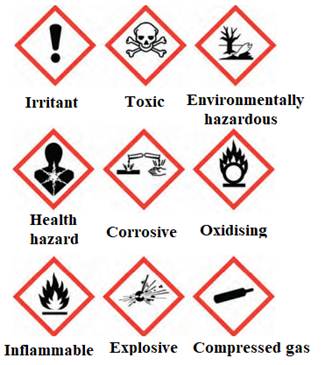
- Irritant: When skin or any delicate part of the body comes in contact with an irritant, it can cause a harmful reaction. Especially, eyes, nasal mucosa and skin are affected by contact with corrosive substances.
- Toxic: Tasting a toxic substance or even smelling it, can lead to death. Containers of these substances are therefore marked as dangerous. They should be avoided as far as possible.
- Environmentally hazardous: Many substances cause harm to the environment due to their toxicity. Air, water and soil can be polluted due to such pollutants. Such substances should be carefully used. Their use should be judicious and controlled.
- Health hazard: Substances that can cause hazard to our health should not be kept in proximity. They should be kept away as far as possible and handled with great care, if needed for any work. Materials marked with health hazard can cause severe toxicity.
- Corrosive: Corrosive substances are very reactive. The mere touch of corrosive substances can cause rapid destruction of skin, eyes, respiratory passage and, digestive organs. Just touching or smelling such substances can cause major injury and thus warning sign of corrosive substances should never be ignored.
- Oxidizing: Some chemical substances are oxidizing. They carry out chemical reactions with rapidly. E.g. If potassium permanganate falls on a cloth, it starts the reaction on its C-C bonds. As a result, the cloth may catch fire. Therefore, oxidizing substances should be handled with care.
- Inflammable: Similar to explosive substances, inflammable materials can also catch fire easily. Therefore, to warn people such a sign is given on materials that can cause hazard by burning.
- Explosive: Some materials are explosive. Care should be taken while handling such materials. If explosion occurs, there would be a major disaster causing great loss of life and property. Thus if this sign is seen, great care has to be taken.
- Compressed gas: Compressed substances are filled under pressure in some containers. If mishandled, they can come out of the container by bursting it open. This can cause major injuries.
Solution 9.a
- Mock drill is the practice to check whether there is preparedness for dealing with a sudden attack of a disaster.
- Virtual or apparent situations that simulate the disaster are created for this purpose.
- The reaction time for any type of disaster is checked by such activity.
- The execution of the rescue plans are observed in the presence of a trained personnel.
- People also understand their responsibilities at the time of an actual disaster.
- The experts also check execution of the plan designed for disaster redressal.
- The efficacy of the entire disaster management system can be understood by such mock drills.
- In future, when actual calamity strikes, there is already preparation for disaster redressal.
- Therefore, mock drill is very useful.
Solution 9.b
- Disaster can strike any time. Sudden disasters can be man-made with some bad intentions or may be accidental.
- When a natural calamity strikes suddenly with a huge impact, large scale devastation of property and general environment degradation occurs along with substantial mortality of people and animals.
- Therefore, it is most appropriate to have preparedness to reduce the impact of any future disasters.
- We cannot control the onset of a natural disaster, but we can definitely reduce the harsh effects of the disaster by following a disaster management plan.
Solution 10
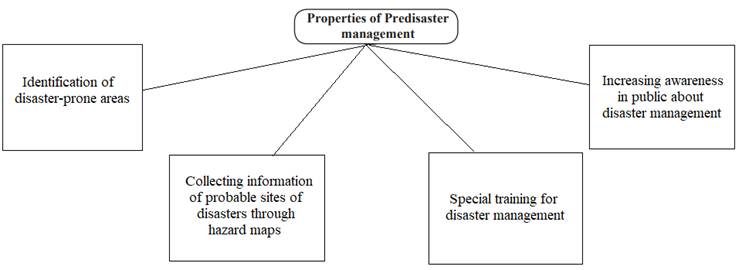
Solution 11
Following disasters are shown in the pictures given:
- There is gas leakage from the LPG cylinder.
- Two groups of children are fighting with each other.
- There is heavy downpour due to cloud bursting which has led to waterlogging in the town.
- There is cyclone causing a tornado. (commonly called a twister).
